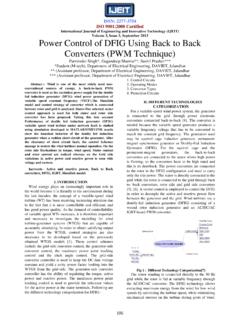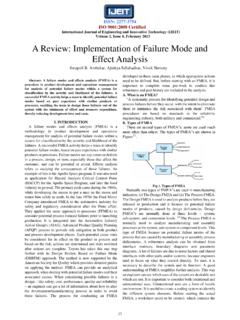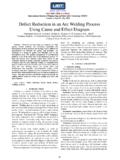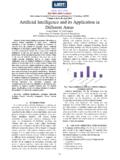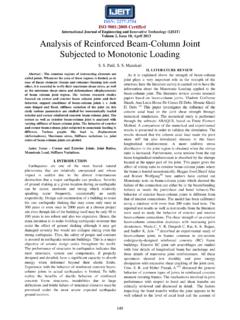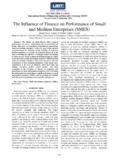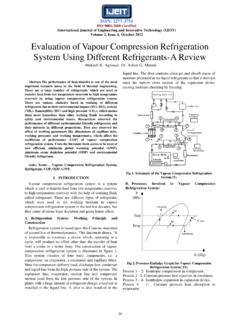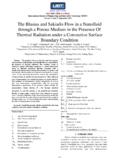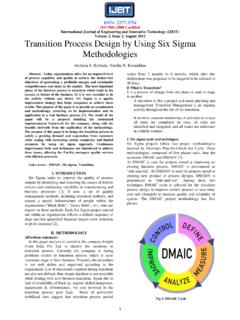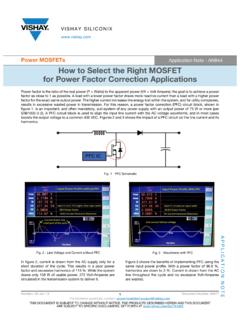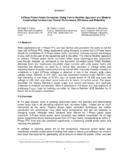Transcription of Power Factor Correction Using PIC Microcontroller
1 ISSN: 2277-3754 ISO 9001:2008 Certified International Journal of Engineering and Innovative Technology (IJEIT) Volume 3, Issue 4, October 2013 272 Power Factor Correction Using PIC Microcontroller Pranjali Sonje, Pursuing MTech, Bharati Vidyapeeth University college of Engineering, Pune Anagha Soman, Assistant Professor, Bharati Vidyapeeth University college of Engineering, Pune Abstract;- In recent years, the Power quality of the ac system has become great concern due to the rapidly increased numbers of electronic equipment, Power electronics and high voltage Power system. Most of the commercial and industrial installation in the contry has large electrical loads which are severally inductive in nature causing lagging Power Factor which gives heavy penalties to consumer by electricity board. This situation is taken care by PFC. Power Factor Correction is the capacity of absorbing the reactive Power produced by a load.
2 In case of fixed loads, this can be done manually by switching of capacitors, however in case of rapidly varying and scattered loads it becomes difficult to maintain a high Power Factor by manually switching on/off the capacitors in proportion to variation of load within an installation. This drawback is overcome by Using an APFC panel. In this paper measuring of Power Factor from load is done by Using PIC Microcontroller and trigger required capacitors in order to compensate reactive Power and bring Power Factor near to unity. Index Terms:- Power Factor , PIC, Hardware I. INTRODUCTION Power Factor is the ratio of KW and KVA. KW is the actual load Power and KVA is the apparent load Power . It is a measure of how effectively the current is being converted into useful work output. Most of industrial electric loads have a low Power Factor not transcending from and thus imparts to the distribution losses.
3 Poor Power Factor can be the result of significant phase angle is generally the result of an inductive load such as an induction motor, Power transformer or induction furnace. [1] The existing of reactive Power does not included in the electric bill yet this probably causes dissipation Power lost at the load which results to an increment of electricity bill charge. Penalty charge is just one of the problems however there are more other problems occur if Power Factor is low. They are A) Extra losses in feeder cables B) Significant voltage drop C) Reduction of effective capacity of cables D) Voltage drop at the secondary of the transformer E) Losses in transformer This paper focuses on the design and implementation of Power Factor Correction Using PIC Microcontroller chip, determine the Power Factor of the loaded Power system, and generate proper action to calculate and to add sufficient capacitor. II. PROPOSED SYSTEM Microcontroller base automatic controlling of Power Factor with load monitoring is shown in block of PFC Using PIC The principal element in the circuit is PIC Microcontroller .
4 The current and voltage single are acquired from the main AC line by Using Current Transformer and Potential Transformer. These acquired signals are then pass on the zero crossing detectors. Bridge rectifier for both current and voltage signals transposes the analog signals to the digital signal. Microcontroller read the RMS value for voltage and current used in its algorithm to select the value of in demand capacitor for the load to correct the Power Factor and monitors the behavior of the enduring load on the basis of current depleted by the load. In case of low Power Factor Microcontroller send out the signal to switching unit that will switch on the in demand value of capacitor. The tasks executed by the Microcontroller for correcting the low Power Factor by selecting the in demand value of capacitor and load monitoring are shown in LCD.
5 III. CIRCUIT DESIGN The design aims to monitor phase angle continuously and the event of phase angle deviation a Correction action is initialized to compensate for this difference by continuous changing variable capacitors value via switching process. A. SENSORS The alternative voltage and current signals are both sensed and scared down Using sensors, while the current is converted into an equivalent voltage representation. the voltage transducer is able to read both DC and AC signal by converting the captured signal into smaller scale with ratio of 2500:1000. The current transducer scares down input signal with ratio of 1:1000. ISSN: 2277-3754 ISO 9001:2008 Certified International Journal of Engineering and Innovative Technology (IJEIT) Volume 3, Issue 4, October 2013 273 B. ZERO CROSSING DETECTOR: As the name indicates the zero crossing detector is a device for detecting the point where the voltage crosses zero in either direction.
6 As shown in the circuit diagram 2 the first section is a bridge rectifier, which provides full wave rectified output. This is applied to the base of the transistor through a base resistor, R2. The capacitor charges to maximum of the bridge rectified output through the diode, D2. This charge is available to the transistor as VCC. The capacitance value is kept large in order to minimize ripple and get perfect dc. The transistor remains OFF until the Cut-in voltage VBE is reached. During the OFF period of the transistor the output will be high and approximately equal to VCC. Fig crossing detector Once the transistor is ON and IB increases according to the input wave, the transistor moves slowly towards saturation where the output reduces to the saturation voltage of the transistor which is nearly equal to zero Initially VBE = Cut-in voltage of diode, the capacitor will charge through the diode Vm where Vm is the maximum amplitude of the rectified wave.
7 Now the diode is reverse biased and hence does not provide a discharging path for the capacitor, which in turn has two effects. Variation in VCC. It will provide base current to the transistor in the region where both diode and transistor are OFF. Thus an output square wave is produced whenever the input voltage crosses zero thereby acting as a zero crossing detector. A zero crossing detector literally detects the transition of a signal waveform from positive and negative, ideally providing a narrow pulse that coincides exactly with the zero voltage condition. At first glance, this would appear to be an easy enough task, but in fact it is quite complex, especially where high frequencies are involved. In this instance, even 1 kHz starts to present a real challenge if extreme accuracy is need. C. CAPACITOR BANK Capacitors are commonly used within a lot of Power system, especially electronic constructed circuitry.
8 In three phase Power system, capacitors normally installed within an isolating nonconductor metal box, which called capacitor bank, they are fixed or switched. Fixed banks are connected permanently to the primary conductors through fused switches. Switch capacitors banks are tied to primary system through automated switch, allowing them to be put on line and taken off line as needed. Distribution Power system usually connects capacitor in parallel rather connecting in series. The function of shunt Power capacitor is to provide leading KVARS to an electrical system when and where needed. The actual capacitor in farads of a capacitor bank can be calculated Using the following equation:[3] C= VAR/2 f*VR2 Where, VAR = capacitor unit var rating C= capacitor in farad F = frequency VR = capacitor unit rated voltage D. RELATION OF CAPACITOR WITH Power Factor as majority Power system has inductive load thus normally only lagging Power Factor occurs hence capacitors are used to compensate by producing leading current to the load to reduce the lagging current, there by shrink the phase angle distance between the real Power and apparent Power .
9 Table 1 describes the common loads appear in general industrial systems and their typical Power Factor . In general, Power capacitors shall be Y connected on the three phase distribution feeder. Grounding the neutral is essential for the fuses to operate in case of any event of capacitor fault. TABLE 1: Typical Power Factor of various loads [5] Load Typical Power Factor Incandescent Lamps Florescent lamps Synchronous Motors 1 to leading Squirrel cage motors High speed Low speed Wound rotor Induction motor Fractional HP 1-10 HP IV. DETERMINE THE SIZE OF CAPACITOR BANKS Standard capacitors sizes are 50,100,150,200,300 and 400 KVAR. Since capacitors can be connected more than one per phase in order to increase the bank size, it is recommended to select two or at most three capacitor unit sizes to avoid stocking the sizes. [7] In a fixed capacitor installation, one should at first determine desired Power Factor value before attempting to design one.
10 By installing fixed capacitor can approximately improve the Power Factor around 94% to 96%. When Using switched capacitor to correct the Power Factor of a circuit, the switch control is set to close the bank onto the line when the load KVARs equal to two-thirds of the banks rated ISSN: 2277-3754 ISO 9001:2008 Certified International Journal of Engineering and Innovative Technology (IJEIT) Volume 3, Issue 4, October 2013 274 KVAR. This scheme is tend to reduce loss by driving the line leading with first turn on before it is turn off, this is referred as the two-thirds rule . Taking a daily load cycle, compare with fixed capacitor bank, switching capacitor bank is generally more expensive thus it is essential to take accounting of the cost of installation so that its time value worth for the investment. A. CAPACITOR SIZE 1) First step is to measure present (old) KVA and PF, or. get them from Power bill 2) Then to calculate active Power , Active Power (kW) =PFold * KVAold 3) Calculate system kVARsys kVARsys = [KVAold2 KW2]1/2 3) Identify a target PFnew 4) Calculate the new kVA Using target PFnew: KVAnew = kW/ PFnew 5) Calculate KVARnew once target PFnew is achieved: KVARnew = [KVAnew2- KW2 ]1/2 7) KVARnew is the difference between kVARsys added capacitor s kVAR: KVARnew = kVARsys - KVARcap 8) So kVAR of the capacitors to be installed is _ KVARcap = kVARsys - KVARnew EXAMPLE:- Given: PF = and motor with nameplate info of 100 hp and 94% efficiency.
